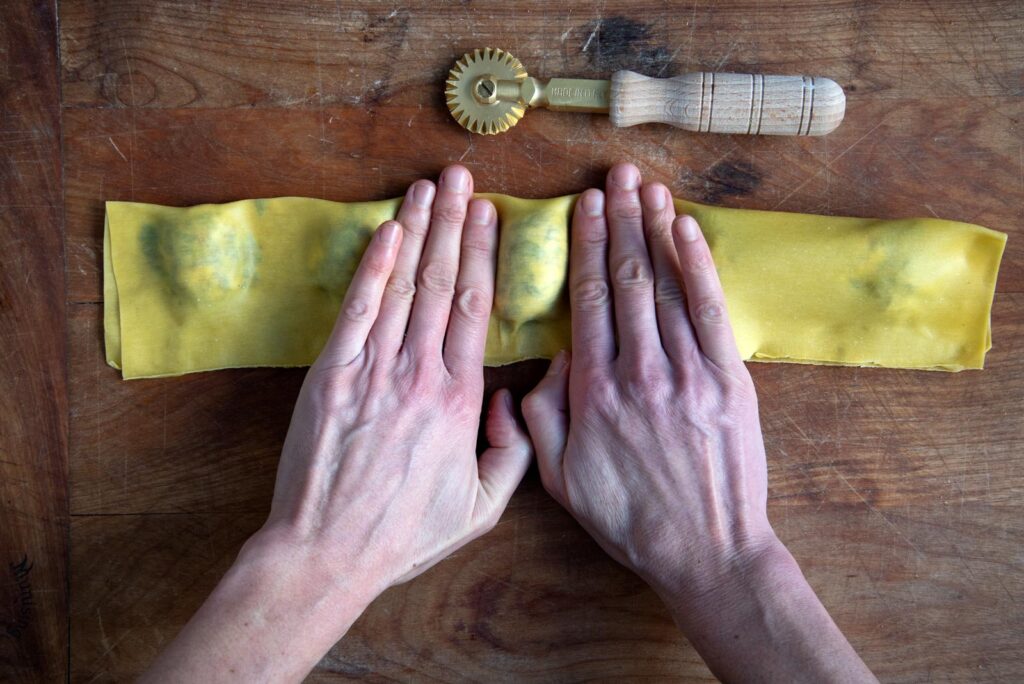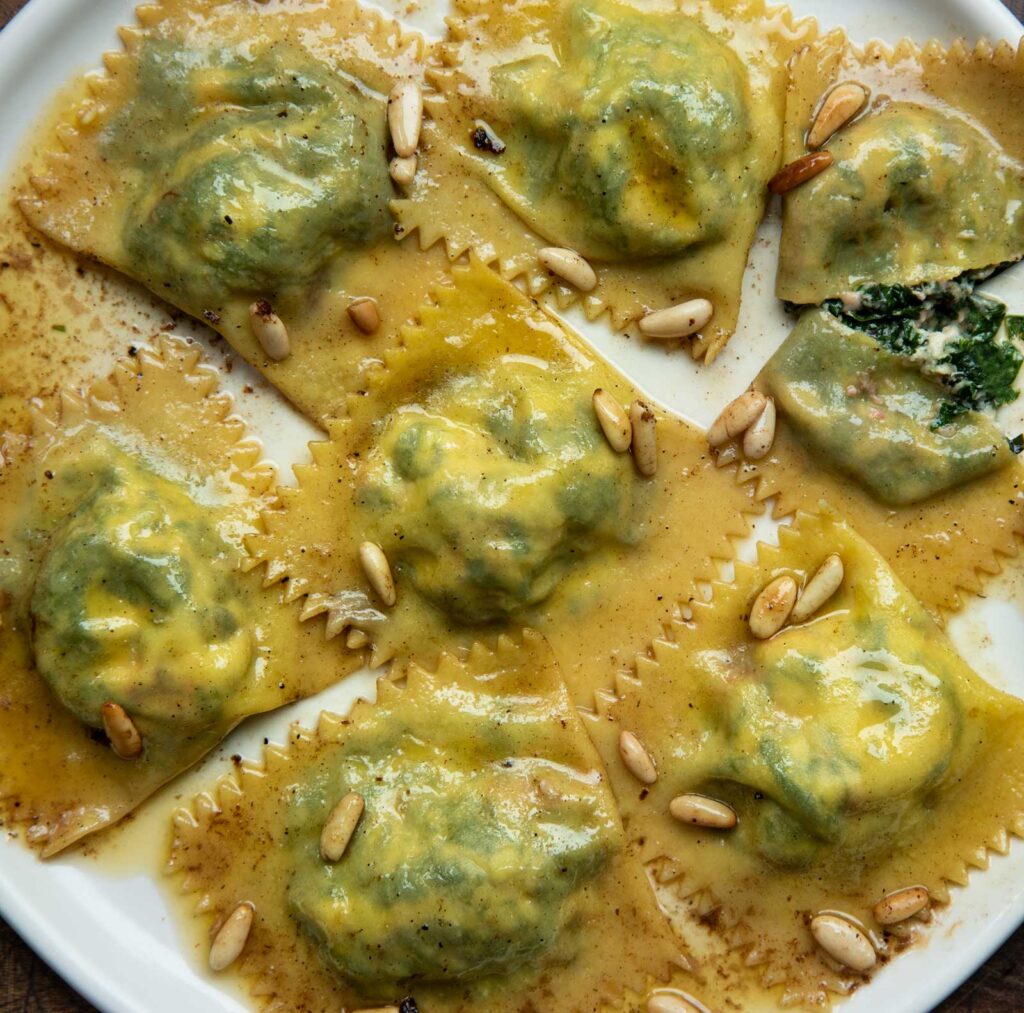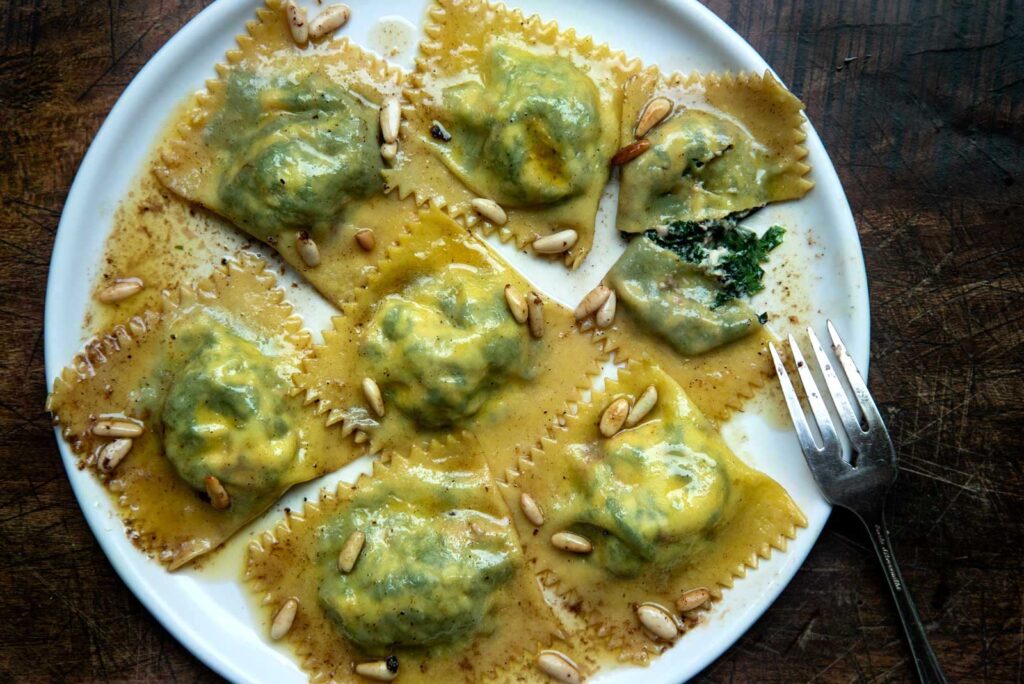When I first started making pasta, the primary question on my mind was…what is the perfect ratio of flour to eggs to yolks? Each recipe I came across had a slightly different ratio of whole eggs/yolks. Hmm…
What I’ve come to learn is that there is no singular “perfect” pasta dough recipe. Probably not the answer you were looking for — me either. In the end, it all comes down to personal preference.
Because quality, pasture-raised eggs can get expensive if you’re making pasta often, I typically go with the standard Italian ratio of 1 whole egg for 100 grams of 00 flour. It works well every time. However, from time to time, I like to experiment — adding more yolks to whole eggs, which yields a richer, more bright yellow dough.
Today, I went heavy on the egg yolks — 250 grams flour (200 grams 00 flour + 50 grams semola), 6 egg yolks, 1 whole egg, a little olive oil and pinch of salt. As you can see it produced a visually pleasing yellow dough. Enough for nearly 40 rather large ravioli.
Kept the filling simple, that is, a good amount of Swiss chard along with ricotta, Parmesan, lemon zest and nutmeg. Serve these plump beauties bathed in brown butter with a squeeze of lemon juice and topped with toasted pine nuts.
Simple and delicious.

I rolled out the dough rather thin (#7 with my KitchenAid pasta attachment).
Make sure to squeeze out as much air as possible.




Chard Ravioli
Ingredients
- 6 tbsp olive oil, divided
- 2 garlic cloves, peeled and lightly crushed with side of knife
- 1/2 pound destemmed Swiss chard, chopped into bite-sized pieces
- salt
- 1 1/2 cups full-fat ricotta
- 3/4 ounce (about 3/4 cup) freshly grated Parmesan
- 1/2 tsp lemon zest
- pinch of red pepper flakes
- 1/8 tsp nutmeg
To Finish the Dish:
- butter
- fresh lemon juice
- toasted pine nuts for serving (optional)
Instructions
- For the filling: Heat 3 tablespoons olive oil in a skillet. Add the garlic, and cook about 2 minutes, until garlic is browned on both sides. Remove and discard the garlic. Add the chard and cook until wilted. Remove and set aside to cool. When cool enough to handle, squeeze out any excess moisture. Place in a bowl. Combine the rest of the ingredients and mix well.
- To form the ravioli: Lightly flour your work surface. Cut off 1/4 of the dough, leaving the rest covered. Flatten the piece of dough with a rolling pin. Next, run the dough through your pasta machine starting with the largest setting (typically ‘0’ or ‘1’). Run it one to two times through each successive pasta roller setting until very thin and translucent, about 1/16th of an inch thick (setting #7 with my KitchenAid roller attachment). Spoon rounded teaspoons, about 1-inch apart along the legnth of the dough. Fold the dough over the filling. Press out as much air as possible between each filling. With a fluted cutter, cut along the length of the unfolded edge (no need to cut the folded edge). Next cut between each filling, forming individual ravioli. Place the ravioli on a baking sheet lightly floured with semola flour to prevent sticking. Repeat with the rest of your filling and dough.Use right away or let dry out a bit then place the sheet pan in the freezer. When the pasta are frozen, transfer to an air-tight container or zip-lock freezer bag.
- To finish the dish: Bring a pot of salted water to a boil. Drop a portion of ravioli in the water. Meanwhile, heat a few tablespoons of butter in a skillet. Add a little pasta water and squeeze of lemon. Whisk to form an emulsion. When the pasta is al dente, about 3 minutes, add to the skillet with the butter and cook, bathing the ravioli with the butter, another minute or two. Serve with toasted pine nuts if you like.
Notes
Egg Yolk Pasta Dough
Ingredients
- 200 grams 00 flour
- 50 grams semola flour
- 6 large egg yolks
- 1 large whole egg
- 1 1/2 tsp olive oil
- pinch of salt
Instructions
- Place the flour on a dry, clean work surface and form it into a mound. Create a large shallow well in the middle, making sure the walls are high enough to prevent the eggs from escaping.
- Add the yolks, whole egg, olive oil and pinch of salt into the well. With a fork, beat the eggs; be careful not to disturb the walls of the flour. Once the eggs are well beaten, begin to incorporate the flour walls into the egg mixture.
- Continue incorporating the flour with the eggs with your fork until you have a shaggy, solid mass. At this point, using your hands, start folding and forming the dough, incorporating the rest of the flour until you have a stiff, solid mass (removing any dry clumps of flour).
- Knead the dough. Drive the palms of your hand into the dough, pushing the dough forward. Continue, rotating the dough and folding the dough over its self, which helps to incorporate air pockets into the dough.
- Repeat until the dough is firm and bouncy and has a smooth, silken texture, about 10 minutes. Wrap the dough in plastic and let rest 30 minutes.

